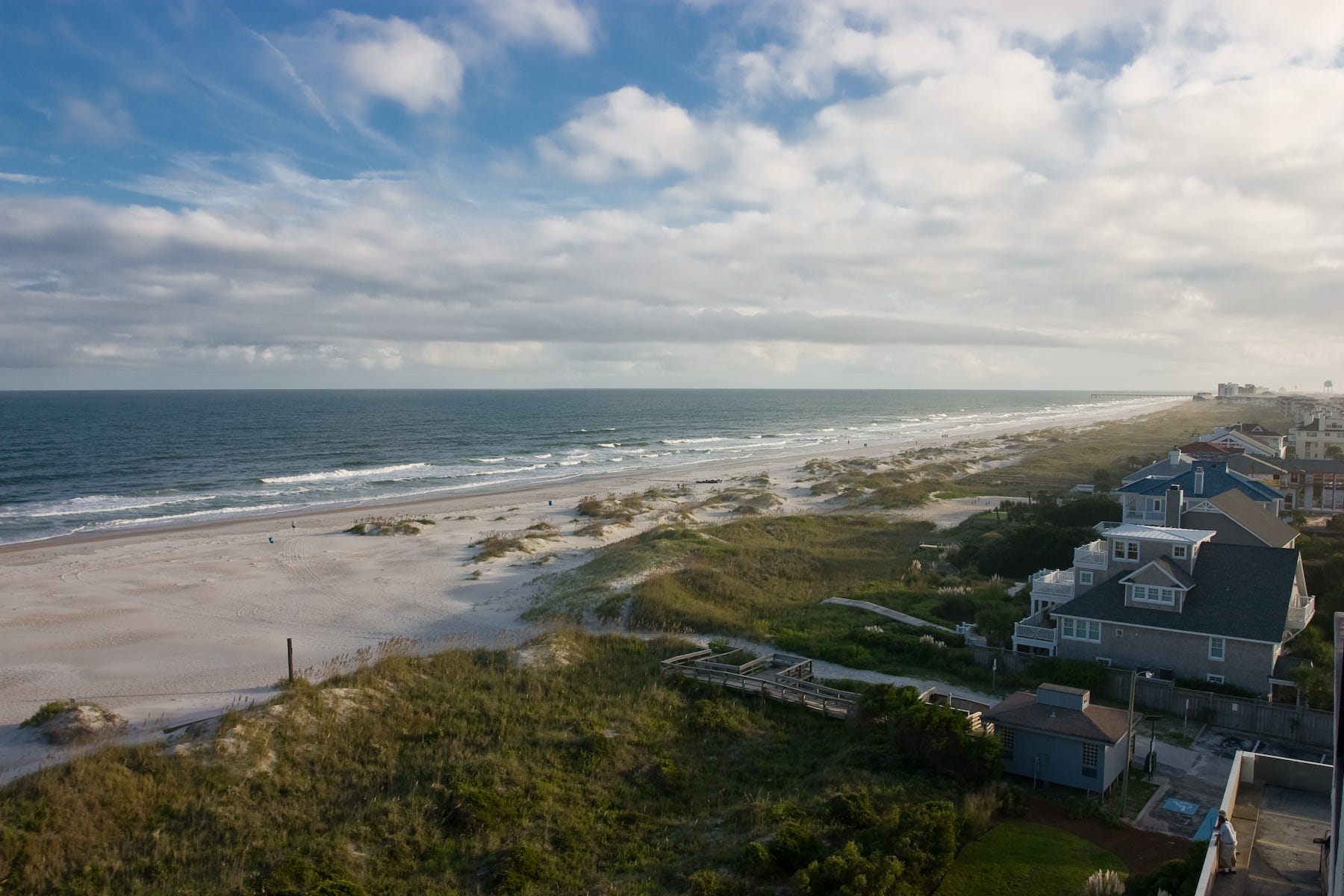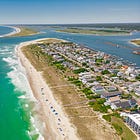A Tale of Two Islands
How America’s Barrier Islands Live and Die with Property Values
Wrightsville Beach and Rodanthe: both are stunning beach towns on barrier islands in North Carolina. Yet these islands are on different paths: One community is reengineering its shoreline while the other is letting the ocean wash away its homes. What determines their fates? Property values.
This is the second post in a series exploring the climate problems facing America’s barrier islands. This week I unpack the economics of barrier islands by comparing the experiences of two North Carolina beach towns.
Are you tired of taking baby steps in the race for our survival? Gumption is a space to make bold climate plans. Subscribe today and join a movement to make climate plans that save the world.
The Property Paradox
Property is both a salve and a disease in the resilience of America’s barrier islands.
Barrier islands’ core industries—tourism, fishing, and food and beverage—are deeply rooted in place. Hotels want to be close to the beach. Fishing harbors want to be close to fertile fishing grounds. Restaurants want to be near large crowds. The islands are small, and it’s expensive to expand their landmasses. Scarcity and demand create value. In Rodanthe and Wrightsville Beach, median home sales are two to three times higher than in the rest of the state.
As island economies grow, so do property values. Owners invest more in their properties, especially in income-producing assets like hotels and large vacation homes. As owners invest more, the replacement values of their properties rise. Replacement value is an estimate of how much money it would take to rebuild the structure on the property. It’s a key component of the cost-benefit calculations policymakers consider when deciding whether to fortify an island with infrastructure. In their formulas, a higher replacement value equals higher project benefits.
The ‘salve’ in this paradox is that property taxes are one of the largest sources of funding local governments can raise to invest in their resilience.
Flooding could plunge the island into a financial crisis. Wrightsville Beach has over $588 million in property values in its 2050s floodplain and over $2.3 billion in its 2100 floodplain. Property-related taxes generate 27% of the town’s annual budget.1 While Wrightsville Beach represents only 1% of the county’s population, its property represents 8% of the county’s total property values. Therefore defending property values is a high priority.
Wrightsville Beach recently faced a crisis of property loss and responded by reengineering the island. Currents naturally carry sand from the island’s northern end to its southern end. By the early 2000s, the island’s northern edge had eroded to the doorstep of Shell Island Resort, one of the town’s most iconic hotels. If the town did nothing, the hotel would have been surrounded by water in a few years. But in 2002 the county extended the island by 2,500 feet to buy the hotel a few more decades. The county paid for this $6.5 million project through a new fee on high-value properties.
The ‘disease’ in this paradox is that efforts to preserve property values—by holding the island in place—can lead to the island’s demise. As I explained in an earlier post, barrier islands are constantly moving and need to move to stay above sea level rise. When we hold an island in place with fortifications, we expose it to catastrophic erosion.
The moving nature of barrier islands is in direct conflict with the fundamentals of American property rights. Property boundaries are virtual and stationary. Perhaps a property’s boundaries followed the shoreline 100 years ago, but not today. For beachfront properties, their land only gets smaller over time as the shoreline creeps closer to the road.
Property rights are also exclusive. If property is submerged and no longer habitable, islands don’t have an easy way of relocating their property. Owners either buy another property on the island or they’re fully displaced.
Given restrictions on property rights, island communities have a strong incentive to hold their islands in place around the virtual boundaries of their properties. Projects like Wrightsville Beach’s shoreline reconstruction project are bandaids that buy time. As climate change accelerates coastal erosion, the town will need to consider these projects more frequently.
If property values continue to keep pace with rates of erosion, coastal communities may be able to preserve their tax bases. But if the costs of defending their islands become too high, the island’s economy could collapse with the shoreline.
Shrinking Economies
Rodanthe is an example of a community where the economic gas in their resilience fuel tank ran dry.
Since the town was first laid out, the beachfront shoreline eroded inland hundreds of feet. By 2004 over 60 homes were on the beach, and by 2009 many of these homes were permanently in the ocean. The homes sat abandoned for years as the town weighed its options.
The federal government owns the beach and offered the town two options: the town could pay for a beach nourishment project or the federal government would buy out two beachfront properties for more than $700,000. The town couldn’t afford the beach nourishment project—they only have 135 residents to support tax revenues. They chose the buyout option.
While Rodanthe’s beachfront property owners were lucky to leave with cash in the bank, buyout programs can chip away at property values and the community's vitality. Lots sit vacant until the government clears the properties, making the town less desirable to live in and visit. Fewer homes mean fewer residents and visitors to support local businesses. In time, the local economy could shrink, and municipal budgets would shrink with it.
With less money to invest in resilience, the shoreline would continue to erode and the cycle continues.

Climate Gentrification
Communities that can afford to defend their islands may continue to see economic growth. But the same forces that fund the islands’ resilience will drive lower-income residents and visitors away. This is a new form of gentrification—climate gentrification.
After a home is destroyed by flooding, the cost of rebuilding is often higher than the value of the original structure. If a homeowner needs to do major repairs after a storm, they’re required to comply with local floodplain regulations. They need to raise the building and reinforce the structure to withstand low-intensity hurricanes. This is the minimum standard, and it can add thousands of dollars to the cost of reconstruction.
If a homeowner wants to truly protect their investment against more intense hurricanes, they need to build a home like the Sand Palace of Mexico Beach. With deep foundations, a metal roof, and storm shutters, building to this standard adds at least $40,000 to the cost of a typical home.2
Finding money to rebuild can take a long time. Half of Americans have less than $5,300 in savings; so most people cannot afford to pay for construction without assistance from their insurer and FEMA. Insurance companies notoriously avoid making payments and delay payouts. Getting financial assistance from FEMA takes years of persistently navigating a complex bureaucracy. For many low- and middle-income property owners, selling and leaving is their best option.
The challenges of rebuilding, mixed with more frequent hurricanes, are pushing low- and middle-income families off barrier islands. These are teachers, firefighters, waiters, and nurses who keep their communities running. Higher-income families—if not new hotels and resorts—are replacing them. Local businesses—facing the same costs as homeowners after a storm—either raise their prices or sell, opening the market to higher-priced businesses.
Local governments have little incentive to stop climate gentrification. As their towns gentrify, property values increase. With higher-value properties to tax, the town has more funding to invest in its resilience.

Future without Action
It’s difficult to predict the future of America’s barrier islands, but the economic forces shaping the islands today suggest that each island is moving down one of two paths. Islands like Wrightsville Beach—which can keep their property values high—are becoming exclusive playgrounds for the rich. Meanwhile, islands like Rodanthe—that cannot afford to protect themselves—are becoming desolate ghost towns, if not drowning entirely.
Market dynamics alone should not determine whether a barrier island is saved. As I demonstrate in this series, America’s barrier islands are worth so much more than the sum of their property values. Barrier islands protect human life, support sensitive natural habitats, and are home to unique American subcultures.
Setting aside value, I’m also concerned about the future of America’s beach culture. Without action, we are moving toward a future in which only the wealthiest Americans will have access to the pristine barrier island beaches of the Eastern and Gulf coasts. A rich history of America’s egalitarian beach culture could be replaced by Dubai-style resorts for the wealthy.
We need to break property’s hold on the future of barrier islands. Property rights need to evolve to meet the needs of a changing climate. The cost-benefit analyses that drive decisions about whether to save an island need to be replaced with more holistic measures. And we need to create new incentives for governments at every level to ensure barrier islands are accessible to people from all backgrounds.
In future posts, I’ll explore how we can put America’s barrier islands on a path toward resilience and fairness. Subscribe today to follow along!
More on America’s Barrier Islands
Your Turn!
What do you value most about America’s barrier islands? Share your thoughts in the comments below or email me at blake@gumption.earth!
“Property-related taxes” for Wrightsville Beach include Ad Valoreum Tax, Sales Tax, and Room Occupancy Tax.
The linked article estimates that hurricane protection features on a home would add $30,000 to construction costs. Forbes published the article in 2012, so I adjusted costs to 2024 inflation values.









The details in the piece are much appreciated. I want to learn more about barrier islands now!
A good illustration of how capitalism is a poor system for responding intelligently to climate change.